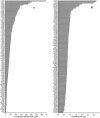Molecular evolutionary dynamics of cytochrome P450 monooxygenases across kingdoms: Special focus on mycobacterial P450s
- PMID: 27616185
- PMCID: PMC5018878
- DOI: 10.1038/srep33099
Molecular evolutionary dynamics of cytochrome P450 monooxygenases across kingdoms: Special focus on mycobacterial P450s
Abstract
Since the initial identification of cytochrome P450 monooxygenases (CYPs/P450s), great progress has been made in understanding their structure-function relationship, diversity and application in producing compounds beneficial to humans. However, the molecular evolution of P450s in terms of their dynamics both at protein and DNA levels and functional conservation across kingdoms still needs investigation. In this study, we analyzed 17 598 P450s belonging to 113 P450 families (bacteria -42; fungi -19; plant -28; animal -22; plant and animal -1 and common P450 family -1) and found highly conserved and rapidly evolving P450 families. Results suggested that bacterial P450s, particularly P450s belonging to mycobacteria, are highly conserved both at protein and DNA levels. Mycobacteria possess the highest P450 diversity percentage compared to other microbes and have a high coverage of P450s (≥1%) in their genomes, as found in fungi and plants. Phylogenetic and functional analyses revealed the functional conservation of P450s despite belonging to different biological kingdoms, suggesting the adherence of P450s to their innate function such as their involvement in either generation or oxidation of steroids and structurally related molecules, fatty acids and terpenoids. This study's results offer new understanding of the dynamic structural nature of P450s.
Figures







References
-
- Guengerich F. P. Human cytochrome P450 enzymes In Cytochrome P450: Structure, mechanism, and biochemistry 4th edn. (eds Oritz de Montellano P. R.) Ch. 9, 523–786. (Springer International Publishing, 2015).
Publication types
MeSH terms
Substances
LinkOut - more resources
Full Text Sources
Other Literature Sources

